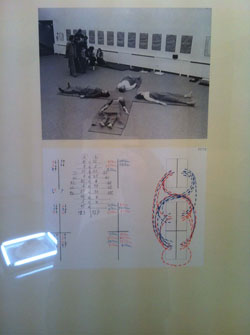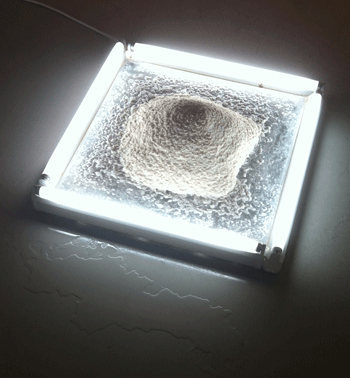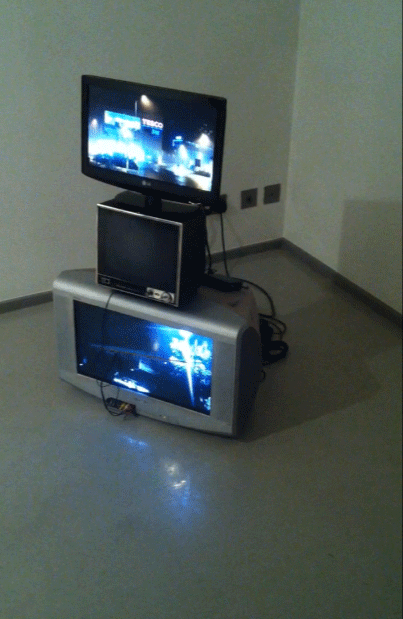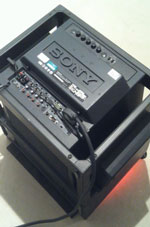 “…and the stage darkens”
“…and the stage darkens”| EXHIBITIONS |
REVIEWS | TALKS AND EVENTS | ARTISTS | IN CONVERSATION |
WRITINGS | ARCHIVES | ABOUT |
|---|
review by Rozemin Keshvani
A show that is even more intriguing than its title, “...and the stage darkens (or this voice is a big whale)” draws inspiration from Peter Shaffer’s 1965 farce ‘Black Comedy’. Shaffer’s play begins in total darkness, but reverses the lighting when a power-cut shuts off the electricity in the play’s mansion flat setting. The actors must learn to navigate a fully lit stage as if in total darkness, calling upon each actor to become intensely aware of her own proprioception. Proprioception is an interoceptive awareness -- the conscious perception of sensations from inside the body that create the sense of the physiological condition of the body, such as heart beat, respiration, satiety, and sensations related to emotions.[1]
Not seeking to overtly disorient the viewer, “...and
the
stage darkens” presents seven works through which we are invited to
become aware
of the self in its act of perception. The
viewer assumes a critical awareness of her mind and body as
the instrument through which perceptual awareness becomes possible. The play raises interesting issues from the
perspective of the audience who are normally unaware of their own
proprioception. Through the experience
of the actors, the audience acquire a meta-level awareness of the
actor’s
proprioception which provides a platform for critical audience
participation in
their experience of the performance. It
is this critical awareness that this exhibition harnesses through a
presentation of works which systematically isolate and engage our
individual
senses. Like the audience in the play,
we begin to recognise the ‘staging’ within the exhibition space as an
overarching set of directions propelling us forward.
Certain ideas become important as we navigate
the works, -- choreography, construction, direction, activation,
performance.
“and the stage darkens” begins with an artwork on
the floor
below us -- Frederic Pradeau’s strange Desertificateur
2005, a mound of calcium chloride framed by terranium lamps.  The calcium chloride acts as a desiccant trapping
the moisture in the air, literally imitating a process of
desertification,
while the heat from the lamps then returns the moisture to the floor to
form small
pools surrounding the work. Desertificateur
draws our attention to
sensations associated with moisture such as thirst, dryness, dampness. Its recycling of the moisture in the room
replicates
the biofeedback of self-awareness, a continual process that involves
oppositions,
return and re-evaluation. Overhead one
occasionally
hears Laure Prouvost's sultry voice in her sound pieces, Pink Cloud 2012 and This
Voice is a Whale 2013 -- “smells of the sea, she swims
away…there’s a
big pink light cloud slowly coming down from hovering ..." while at
eye-level on the wall are six images from Franz Erhrad Walther’s, Portfolio
1974, an artist who pioneered working with the body as a form of
social
action and who understood his art as an ‘instrument for process’,
offering up material,
particularly fabric, as opportunities for individual participation and
institutional
transformation.
The calcium chloride acts as a desiccant trapping
the moisture in the air, literally imitating a process of
desertification,
while the heat from the lamps then returns the moisture to the floor to
form small
pools surrounding the work. Desertificateur
draws our attention to
sensations associated with moisture such as thirst, dryness, dampness. Its recycling of the moisture in the room
replicates
the biofeedback of self-awareness, a continual process that involves
oppositions,
return and re-evaluation. Overhead one
occasionally
hears Laure Prouvost's sultry voice in her sound pieces, Pink Cloud 2012 and This
Voice is a Whale 2013 -- “smells of the sea, she swims
away…there’s a
big pink light cloud slowly coming down from hovering ..." while at
eye-level on the wall are six images from Franz Erhrad Walther’s, Portfolio
1974, an artist who pioneered working with the body as a form of
social
action and who understood his art as an ‘instrument for process’,
offering up material,
particularly fabric, as opportunities for individual participation and
institutional
transformation.
 Descending the stairs, we
encounter Haroon Mirza’s
captivating Tescotrain (Homage to Guy Sherwin)
2012, a work of three
vertically stacked interlocking monitors playing two short videos the
artist filmed
through his car windshield on a rainy evening with his iphone. The top LCD television provides a night-time
street view of a shopping plaza shot from an angle that accentuates the
artificial
light, its central feature a partially burnt out and flashing neon
Tesco extra sign,
the letters “ex” no longer visible. The
motion
of the windshield wipers forms an intermittent arc from within the
frame interrupting
the landscape; its hypnotic wave-like motion alludes to the wave form
of energy
that is light and sound. On the bottom a
widescreen cathode ray tube television plays a second night-time scene. A stream of flashing lights stretch diagonally
across the widescreen simulating the lights of an oncoming train. A track-like copper strip is taped to the
screen and connected to the analog television.
The copper strip acts as a conductor, reading the flashing
screen and replaying
it as analog distortion. The work
dissects the audio from the light in our experience of neon
reconnecting these
in a series of three interlocking monitors, LCD, widescreen cathode ray
and
analog, using different signals whose energies are transformed into
feedbacks
that generate different experiences.
Light becomes sound, sound becomes light and together they
become the
new form of energy we experience, both recoding past events and
disassembling
them to interact as a future contingency.
Technologies merge to create something new.
Each monitor acts as an imperfect transducer
converting the signal from one form of energy into another form of
energy. The work might be described as
“lost (and
found) in translation”. Tescotrain
revisits the question of mind/body
dualism and challenges us to wonder whether the body is merely an
instrument of
perception, not so different from other instruments of perception, just
another
form of technology capable of reading and interpreting data. Tescotrain
is visceral. It enters deep within the
body, simulating the sound of the heart as might be experienced from
inside the
body – proprioception – to become a coherent acoustic-visual
composition that directly
addresses the artist’s interest in the synthesis of light waves and
sound waves
to create a new form of perception.
Descending the stairs, we
encounter Haroon Mirza’s
captivating Tescotrain (Homage to Guy Sherwin)
2012, a work of three
vertically stacked interlocking monitors playing two short videos the
artist filmed
through his car windshield on a rainy evening with his iphone. The top LCD television provides a night-time
street view of a shopping plaza shot from an angle that accentuates the
artificial
light, its central feature a partially burnt out and flashing neon
Tesco extra sign,
the letters “ex” no longer visible. The
motion
of the windshield wipers forms an intermittent arc from within the
frame interrupting
the landscape; its hypnotic wave-like motion alludes to the wave form
of energy
that is light and sound. On the bottom a
widescreen cathode ray tube television plays a second night-time scene. A stream of flashing lights stretch diagonally
across the widescreen simulating the lights of an oncoming train. A track-like copper strip is taped to the
screen and connected to the analog television.
The copper strip acts as a conductor, reading the flashing
screen and replaying
it as analog distortion. The work
dissects the audio from the light in our experience of neon
reconnecting these
in a series of three interlocking monitors, LCD, widescreen cathode ray
and
analog, using different signals whose energies are transformed into
feedbacks
that generate different experiences.
Light becomes sound, sound becomes light and together they
become the
new form of energy we experience, both recoding past events and
disassembling
them to interact as a future contingency.
Technologies merge to create something new.
Each monitor acts as an imperfect transducer
converting the signal from one form of energy into another form of
energy. The work might be described as
“lost (and
found) in translation”. Tescotrain
revisits the question of mind/body
dualism and challenges us to wonder whether the body is merely an
instrument of
perception, not so different from other instruments of perception, just
another
form of technology capable of reading and interpreting data. Tescotrain
is visceral. It enters deep within the
body, simulating the sound of the heart as might be experienced from
inside the
body – proprioception – to become a coherent acoustic-visual
composition that directly
addresses the artist’s interest in the synthesis of light waves and
sound waves
to create a new form of perception.
Echoing Mirza’s installation is Laure Provoust’s
delightful
yet somewhat dark video installation, Deeper
2010.  In twist of comedic intervention, the artist
reverses
the iconic Sony cube monitor to face the floor.
Provoust’s screen mirrors the screen in Shaffer’s play, an
inversion of expectations
that is both layered and intensely funny.
Remaining mostly hidden, the image casts a shadow of shifting
colours on
the floor below while the artist’s voice forms a conspicuous soundtrack
of increasingly
anxious supplications:
In twist of comedic intervention, the artist
reverses
the iconic Sony cube monitor to face the floor.
Provoust’s screen mirrors the screen in Shaffer’s play, an
inversion of expectations
that is both layered and intensely funny.
Remaining mostly hidden, the image casts a shadow of shifting
colours on
the floor below while the artist’s voice forms a conspicuous soundtrack
of increasingly
anxious supplications:
“I wish it was
dark here and deeper…and feel it pushed a bit further, in, deeply in,
in, be in
the work, deep in, deep in the work….. I wish the floor would go
deeper, and
this video would go deeper, pushed in, pushed in…deeper, deeper in,
deeper. I wish the video would go deeper.
I wish this work were deeper, deeper. I
wish this could push the floor further and deeper and this floor would
be
deeper…”
A self-portrait of the frustrations
inherent in the creative process, we can almost feel the artist
pressing on the
inside of the screen as she pushes the monitor deeper and deeper in the
floor. The monitor takes on the form of
the body of
the artist while we are given a glimpse into what transpires in her own
mind.
Separating these two powerful installations is
Florian
Roithmayr’s Grotto 2013, a seemingly
casual intervention into the viewer’s
experience that interrupts two spaces. Its
canopy of blue fabric activates the possibilities latent in Walter’s
images upstairs,
while opening a space which allows us to appreciate Ryan Gander’s It’s
got such a good heart in it 2012.
A wallpapered digital print, Gander choreographs the scene,
presenting a
tantalising narrative through the flattened image.
One can quite literally feel the lioness
experiencing pleasure from rubbing against the roped ‘cat scratcher’. Staging and positioning within and without
Gander’s
work is critical. Just what is a lioness
doing in this basement gallery?
Imprisoned in her cage as she is imprisoned in the image as the
work
becomes imprisoned in the institution as the mind seems imprisoned in
the body.
What was performance becomes image;
while image when activated by the viewer, once again becomes
performance.
This idea is also explored in Elaine Cameron-Weir’s
subtle Corsage,
Night Light 2013. Known for
creating work that stimulate the olfactory senses, it is the absence of
an
expected smell that draws my attention.
Corsages are typically made from flowers. Flowers
are typically fragrant. Yet Corsage
is work of neon and fabric. The fabric is white neoprene – the illusory purity
of a bride. A chemically engineered
material
often used in manufacturing space suits and wetsuits, neoprene raises a
host of
environmentally sensitive issues. It is
known
for its distinctive smell and can also be a breeding ground for odorous
bacteria. Unlike Mirza who focuses on
neon’s fluidity
-- the sound waves and light waves of neon, Cameron-Weir speaks to
neon’s quality
as material – the glass tubing which can be shaped and then becomes
brittle, in
contrast to the neoprene – material which, like experience, may never
be fully
shaped and has the potential to transport us to new spaces.
“and the stage darkens” presents works which
together activate
our psycho-physical awareness of ourselves as a physical embodiment
within a
larger space that is at once outside and inside. It
gives us a glimpse into our awareness as a
multi-dimensional matrix, a possible world, and by its critical
engagement of
the viewer within the exhibition platform, it puts forward a new
reading of the
art exhibition as a possible Gesamtkunstwerk.